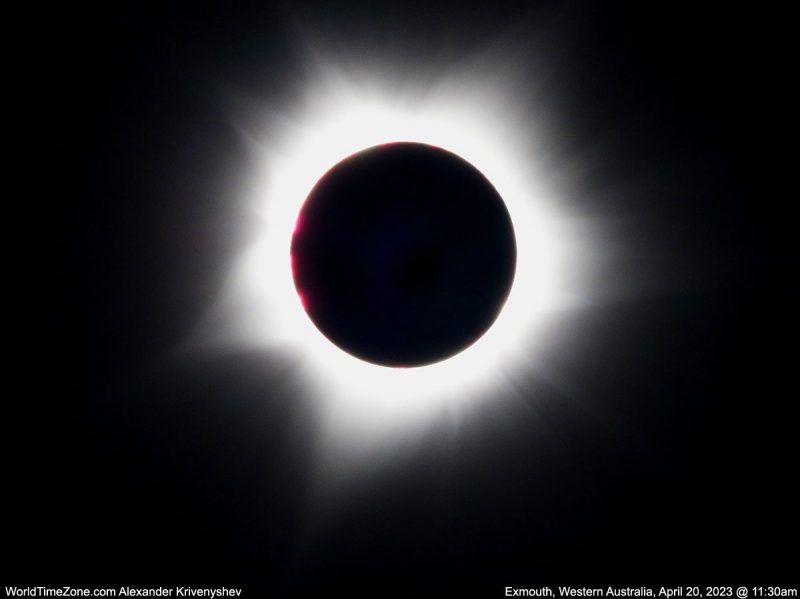
April 8 solar eclipse maps are wrong
If you’re planning to watch the April 8, 2024, total solar eclipse from a location along the edges of the path of totality, you’ll want to check the latest map to make sure you don’t miss the big moment.
In other words, your eclipse map needs an update! Why? It’s because scientists are always learning new things. In this case, they have a newly refined measurement of the radius of the sun itself. If the sun is not the size we thought it was … then all eclipse maps made with that earlier sun measurement are wrong. But not by much.
Jamie Carter of Forbes.com – the self-described world’s only total solar eclipse journalist – posted a great article about the change on Saturday (March 30, 2024). Carter said the available maps are off by about 2,000 feet (610 meters) on most of the northern and southern edges.
It’s not a big change. But it could mean disappointment for those watching in their backyards, from the pathway margins. Carter wrote:
For those heading far into the path of totality – which is about 115 miles [185 km] wide, on average – it has little consequence. But for locations on the edge, where most maps suggest that totality will be brief, there’s now a risk that it won’t happen at all.
We aren’t sure how big the sun is
The sun’s size in our sky is a critical factor in determining how broad the moon’s shadow will be as it sweeps along Earth’s surface. But – like all things in astronomy, and in science in general – our knowledge of the sun’s size is still being refined.
We talked with heliophysicist C. Alex Young of NASA Goddard Spaceflight Center. He’s a co-author on our daily sun news post. Alex contributed to some recent work on the sun’s size from Ernie Wright, a programmer and animator in the Scientific Visualization Studio at NASA Goddard. The new works includes refinements in our knowledge of the sun’s size and hence the need for a last-minute alteration in eclipse maps.
We asked Alex why no one noticed the need for this refinement in eclipse maps prior to this year. Or did they notice it? Turns out they did, at the last total solar eclipse to cross North America, in 2017. Alex said:
Some of this was noticed in 2017. That was part of the reason for the paper Ernie Wright just finished.
So, the sun is now known to be slightly larger than we thought. Jamie Carter said:
The standard value is 959.63 arc seconds (an arc second being one 3,600th of a degree) and has been accepted since the late 1800s. It’s used in most eclipse maps and effectively determines the edge of the path of totality.
But it’s wrong. The sun appears to be larger.
Recalculating the path
Expert eclipse mapmaker John Irwin has recalculated the path of totality using a more accurate estimate of the sun’s radius (959.95 arc seconds). He produced the map embedded below. Irwin’s map shows the entire northern edge of the path of totality is narrower than we thought, while the southern edge is wider in Texas but narrower everywhere else.
This newly available map of the April 8 solar eclipse by John Irwin predicts a narrower path of totality across North America. The adjustment could mean some observers on the margins may miss the big moment. Via John Irwin/ Besselian Elements.com.While the discrepancy isn’t huge, it does mean that some people – those along the edges of the eclipse path – who thought they were in the path of totality may no longer be in the path. Carter wrote:
It has alarming consequences for cities dissected by the edges of the path of totality, such as Montreal in Canada. The city’s Cité Jardin and its park – which contains the Olympic Village and the Olympic Stadium – are within the path of totality in standard eclipse maps. On Irwin’s, Cité Jardin is just outside.
Staying on the edge for a more profound eclipse experience
Irwin created a more precise eclipse map that takes into account surface details of Earth and its moon, as well as the better measurement of the sun. BesselianElements.com says this can give adventurous viewers a more thrilling experience on eclipse day:
Most notably, this path incorporates adjustments that account for the topographic elevation, both around the limb of the moon and on the surface of the Earth. It therefore provides a reliable guide for intrepid observers who may wish to venture close to the path limits and witness prolonged, and potentially profound, edge effects around the time of maximum eclipse (weather permitting).
BesselianElements.com eclipse calculator Luca Quaglia, speaking with Carter, said there is still no agreement about the correct figure for the sun’s diameter:
One day, perhaps, new values for the ‘eclipse solar radius’ might be widely adopted – and we’ll finally have an accurate figure for the sun’s radius. Unless, of course, it changes. “There is evidence that the solar radius has changed over the centuries,” said Quaglia. “We need a methodology that reliably, repeatedly and accurately allows for the measure of the solar radius during an eclipse.”
Bottom line: A new map of the April 8, 2024, total solar eclipse shows a narrower path of totality than previously calculated.











